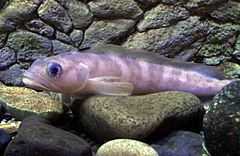Ronquil
| Ronquils | |
|---|---|
 | |
| Searcher (Bathymaster signatus) | |
| Scientific classification | |
| Kingdom: | Animalia |
| Phylum: | Chordata |
| Class: | Actinopterygii |
| Order: | Perciformes |
| Family: | Bathymasteridae D. S. Jordan & C. H. Gilbert, 1883 |
| Genera[1] | |
|
Bathymaster | |
Ronquils (sometimes spelt ronchils) are perciform marine fish of the small family Bathymasteridae. Found only in Arctic and North Pacific waters, the ronquil family contains just seven species in three genera. The larger species are important to commercial fisheries as food fish. Ronquils are most closely related to the eelpouts and prowfish.
The name ronquil is said to derive from the Spanish ronquillo meaning "slightly hoarse". The family name Bathymasteridae can be translated from the Greek to mean "deep searcher".
Physical description
With predominantly drab colours in shades of orange and olive, greatly elongated bodies and large rounded heads, ronquils could easily be mistaken for blennies. Their eyes and terminal mouths are large, with a single long, continuous dorsal fin which begins just behind the head; the anal fin is similarly extensive, and both it and the dorsal fin may either have one or two spines, or none at all. The pectoral fins are also quite large, and like the much smaller tail fin, rounded. The reduced pelvic fins are located in a thoracic position, just behind the throat.
The lateral line runs high along the flanks of the ronquil, ending with the dorsal fin. The fish have palatine teeth; that is, teeth located on the palate or roof of the mouth. The largest of the seven species is the searcher (Bathymaster signatus) at up to 30.5 cm in length.
Marked sexual dimorphism is observed among ronquils. For example, male northern ronquils (Ronquilus jordani) have orange backs with iridescent blue anal fins bordered in black, while the females have olive backs and paler blue anal fins bordered in brown.
Habitat and behaviour
Inhabiting cold waters from the Siberian and Bering Seas south to Hokkaidō and Monterey, California, ronquils are benthic animals, spending most of their time on or near the bottom. They may be found on sandy or rocky substrates, usually no deeper than 275 m (although searchers have been recorded to 825 m); some may be found in tide pools. When threatened, ronquils retreat into the nearest hiding place, such as a hole or crevice.
Ronquils feed primarily on small benthic crustaceans and mollusks. Large halibut and flounders are among the most significant predators of ronquils. Although considered fairly common, ronquils are rarely observed; this is likely owing to their secretive nature.
Few specifics are recorded regarding ronquil spawning, but the males are known to guard the brood.
See also
- List of fish common names
- List of fish families
References
- ↑ Froese, Rainer, and Daniel Pauly, eds. (2013). "Bathymasteridae" in FishBase. February 2013 version.